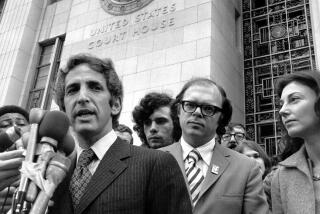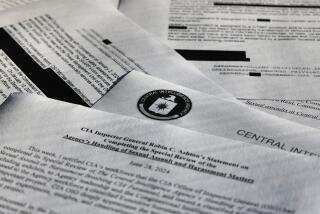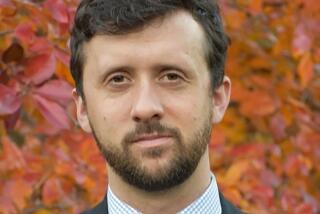FBI Mole Betrayed a Top U.S. Spy
- Share via
WASHINGTON — Confessed FBI spy Robert Philip Hanssen, revealing new secrets about the damage he did to U.S. national security, has told government debriefers that he gave the Russians the identity of one of Washington’s most valuable double agents more than two decades ago, sources said.
Hanssen’s disclosure suggests that he began exposing American-backed agents at least five years earlier than U.S. intelligence officials had feared, and it could rewrite a notorious chapter in Cold War espionage.
Hanssen says that he exposed the identity of a legendary Soviet spy known by the code name “Top Hat” in about 1980, eight years before the Soviets executed the double agent for espionage, intelligence sources say. Hanssen’s revelation could throw into question the reliability of military secrets that the United States culled from the Soviet Union during that time.
The debriefings of Hanssen have also raised worries that fellow FBI agents unwittingly gave him sensitive information in casual conversation that he passed on to the Soviets, an indication that too much information is available to too many agents within the bureau.
Hanssen had direct access as an FBI supervisor to highly classified data and used his knowledge of computers to make additional computer entries, allowing him to give the Russians information about U.S. agents, eavesdropping technology and other sensitive matters. But officials suspect that Hanssen must have gotten some information through other means.
Critics say that computer linkups in recent years have given too many people in the intelligence community access to sensitive data. “It’s out of hand,” said one official.
Hanssen’s ability to glean information from other counterintelligence agents, if confirmed, will likely prompt the FBI and other agencies to better ensure that only those who “need to know” have access to classified information, officials involved in the Hanssen case say.
U.S. intelligence agents began conducting secret, twice-weekly debriefings of Hanssen this summer at an undisclosed location, but a Sept. 11 session was cut short by the terrorist attacks, according to sources close to the case.
The Hanssen briefings resumed last week, and what Hanssen tells authorities will likely receive even closer attention from U.S. intelligence officials in the wake of the terrorist hijackings. There is a growing consensus that intelligence failures contributed to the hijackers’ startling acts, and Atty. Gen. John Ashcroft said Sunday that the United States must do a much better job of gathering information not only on suspected terrorists but on spies and foreign agents as well.
As U.S. intelligence officials reconstruct Hanssen’s espionage career, they have also begun reexamining how he may have obtained access to top-secret information.
A longtime FBI counterintelligence official, Hanssen pleaded guilty in June to charges that he sold national security secrets to the Russians in exchange for $1.4 million in cash and diamonds. In a deal that allowed him to avoid the death penalty, Hanssen agreed to tell the government everything he did during his two decades as a spy.
Hanssen’s government debriefings will likely continue through the end of the year. If prosecutors believe Hanssen lived up to his end of the bargain and cooperated fully, he would be sentenced in January to life in prison without parole. As part of the deal, his family will receive part of his FBI pension.
Even before Hanssen began cooperating, authorities used information from Russian sources to piece together vast amounts of evidence about his spying.
Among other breaches, authorities determined that in late 1985, Hanssen confirmed for the Soviets the names of three Russian agents who were secretly working for the United States. The double agents had been exposed months earlier by another Soviet spy--CIA agent Aldrich H. Ames.
The Russians executed two of the KGB agents who were given up by Ames and Hanssen--Valeriy Martynov and Sergey Motorin--according to the grand jury indictment returned against Hanssen earlier this year.
But Hanssen’s betrayals apparently went further. He revealed only recently, during the course of his ongoing government debriefings, that he gave up a much bigger fish.
The third agent was Dimitri Polyakov, a top Soviet military officer who began secretly working for the United States in the early 1960s.
Polyakov was considered one of the most important spies the United States ever cultivated. He was a “walk-in”--meaning that he was not recruited as a spy, but rather contacted the FBI in New York City to offer his services because of his apparent disillusionment with the Communist system.
At the height of the Cold War, the FBI and later the CIA relied extensively on the intelligence Polyakov gathered, as he passed on information about Soviet nuclear and military capabilities and the identities of several Russian spies. Sino- Soviet material that he photographed detailing Moscow’s bitter split from China was even used by President Nixon and Henry A. Kissinger to help forge relations with China in 1972, according to historical accounts.
A Soviet general, Polyakov was so revered within the U.S. intelligence community that when batches of his secret intelligence dispatches would arrive at the CIA, “it was like Christmas,” James Adams wrote in his 1995 espionage book, “Sellout.”
All that ended in 1988 when the Russians executed Polyakov for espionage, reportedly with a gunshot to the back of his head.
Among a slew of American-backed agents who were discovered and killed by the Soviets during the 1980s, Polyakov was considered perhaps the biggest loss. Indeed, the mystery of how one of America’s most skillful double agents was discovered would gnaw at U.S. officials for years.
Immediately after Polyakov disappeared, some U.S. officials suspected that Edward Lee Howard, a fired CIA agent-turned-Russian spy, must have given him up. Years later, after the U.S. caught Ames spying for the Russians in 1994, he was blamed for outing Polyakov in 1985.
But in fact, Hanssen has recently told U.S. debriefers that he was the one who gave up Polyakov years earlier.
Hanssen, working for the FBI in New York in 1980, had already begun an early foray into spying. He initiated anonymous contact with the GRU, then the Soviet Union’s military intelligence service, and offered to provide classified U.S. intelligence.
In his recent government debriefings, Hanssen has admitted that during those early contacts with the Russians in or around 1980, “he told the GRU that Polyakov was a source of the FBI,” according to an official familiar with the debriefings.
Hanssen may have identified Polyakov to the Soviets as a way of demonstrating his bona fides and “giving them an indication of what he was capable of doing,” according to one national security official who asked not to be identified.
The damage, he said, was staggering. “When you have someone like Hanssen penetrating U.S. intelligence and giving up a live source like Polyakov, that’s very, very significant. That’s something we can’t tolerate,” the official said.
The revelation also raises potentially troubling questions about why the Soviets would have waited eight years before they executed Polyakov.
According to one working theory, the Soviets might have doubted the reliability of the information they received in 1980 from a new and relatively untested spy such as Hanssen. Not until Ames confirmed Polyakov’s identity five years later did the Soviets become convinced that they had a double agent in their midst, some U.S. officials suspect.
But by another theory, the Soviets might have confronted Polyakov in 1980 and used him immediately to feed disinformation back to the Americans, until he was executed eight years later.
Indeed, according to Adams’ “Sellout,” the Soviets unexpectedly ordered Polyakov back to Moscow from his foreign assignment in June 1980. The reassignment so troubled Polyakov’s CIA handlers, who feared he might have been betrayed, that they arranged an emergency meeting with him and assured him he was always welcome in the United States.
Soon afterward, the semi-retired Polyakov resumed his delivery of valuable secrets to the United States, and relieved U.S. officials wrote off the episode as a false alarm.
U.S. intelligence officials may now have to determine whether the Russians used Polyakov to pass bad information to the Americans about their nuclear and military capabilities. That information, while dated, may still be relevant today for U.S. policymakers.
“The significance is that we don’t really know what happened between those years--whether [Polyakov] was ‘played back’ on us or what,” said one source close to the case.
More to Read
Sign up for Essential California
The most important California stories and recommendations in your inbox every morning.
You may occasionally receive promotional content from the Los Angeles Times.










